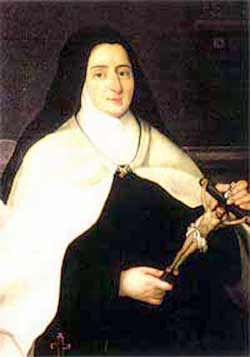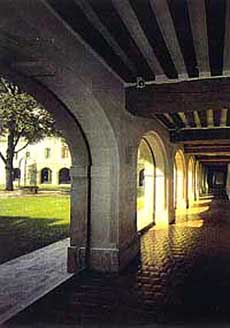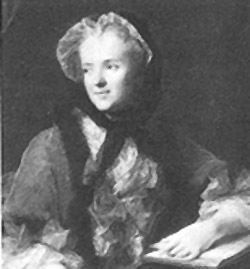 |
The Saint of the Day
Venerable Therese of St. Augustine,
December 23
Prof. Plinio Corrêa de Oliveira
Biographical selection:
In the world Mother Therese of St. Augustine was Princess Louise Marie of France, daughter of King Louis XV and Queen Maria Leczinska. She was born in Versailles on July 15, 1737. When she was still very young she had an accident and almost died. The nuns from a nearby convent made a vow to Our Lady asking that her life be spared, and she was miraculously cured. She never forgot this, and religion marked her deeply. She was known for being extremely generous to the poor.

Princess Louise of France, daughter of Louis XV, left the court to become a Carmelite nun |
She also had a very strong character. One day she was hunting in Compiègne and her horse, meeting a racing carriage that was careening out of control, reared and threw Louise from the saddle to the ground. She hit the carriage, and could easily have been killed or badly hurt, but her life was spared and she was unharmed. Her companions suggested that she return to the castle in a carriage. She laughed, jumped back on her horse, brought the nervous animal under control, and continued her ride. Upon her return, she went to thank the Holy Virgin for what she called the second saving of her life.
Later, deciding to become a Carmelite, she began to study the rule and distance herself from the luxury of court life. When she was considered ready, she asked permission of her father, the King of France, and entered the Carmelite Convent of Saint-Denis in February 1770. All of France admired this example. Pope Clement XIV wrote a letter to compliment her for such a gesture.
In the convent she strove to not be treated as the daughter of the King. She also strove to say her prayers kneeling, which was very difficult for her, given a defect of one leg caused by the childhood accident. With the veil, she received her new name in religion – Therese of St. Augustine.

Cloisters in the Carmelite Convent
of Saint-Denis |
After many years of sacrifice, always embraced with joy, she was elected Superior of her convent. In this role she distinguished herself for the charity she showed to her religious daughters and the severity with which she treated herself, as well as for a great fidelity to the spirit of the religious rule.
She took advantage of her social situation to benefit religion and the salvation of souls. It was her influence that convinced King Louis XVI to open France to many Austrian Carmelites persecuted by Emperor Joseph II. She constantly prayed for the King, for France, and for the French people. To end her good influence over Louis XVI, the enemies of religion determined to kill her. It is almost certain that she was poisoned. In November 1787 she felt terrible stomach pains that gradually became worse. They ended soon with her death. These were her last words: “It is time to go. Let us stand up and run toward Paradise.” It was December 23, 1787.
During the French Revolution the mob ransacked her grave and dispersed her relics. But she continued to work a great number of miracles. For this reason her cause for sainthood was introduced at the Vatican. Pius IX declared her Venerable on June 19, 1873.
Comments of Prof. Plinio:
A thing that is worthwhile to note is that Princess Louise of France had a much greater role at court than this selection reports.

The good current at the French court was represented by Queen Maria Leczinska, mother of Princess Louise |
The reason was the following. Louis XV, her father, led an immoral life, having public concubines, the principal being Madame de Pompadour, and after her, Madame du Barry. Since the time of Louis XIV, two parties of influence had developed at court, one revolutionary, and the other, in opposition to it, was Catholic. At that time these two very defined currents were strongly present in the French court. The good current was represented by Queen Maria Leczinska; it supported her and used to make all kinds of sabotage against the public appearance of the concubines. The bad current was represented by Voltaire, the Encyclopedia, the French Masonry and those vile persons, who in order to please the King and encourage bad morals, supported the concubines.
The royal family – the Grand Dauphin Louis and his wife, a Bavarian princess, and his four sisters, who were daughters of the King – constituted the center of the reaction against the immoral life of the King. The Dauphin and his wife died in 1765 – the hypothesis that they were poisoned is frequently raised by historians – and the four unmarried daughters, Adelaide, Victoire, Sophie and Louise, became the head of this opposition. They lacked the prestige of the Dauphin, who was heir to the throne and a man, but they maintained the good position.

The height of immorality and of virtue lived side by side at the court of King Louis XV, above |
Princess Louise, who after her death was proclaimed venerable, was the head of the good party at court, and had also had an important influence over one of her nieces, Princess Marie Clotilde, who later married the Duke of Savoy and King of Piedmont, and was herself beatified. Therefore, the very immoral King Louis XV had one daughter and one granddaughter who were raised to the honor of the altars, one as venerable and the other blessed. From this you can see that in those times both the height of immorality and of virtue lived side by side at the court.
Princess Louise was, therefore, one of the pillars of morality in the French court, and as such, one of the pillars of morality of the whole kingdom.
When she left the court to enter the convent, Princess Louise made an act of confidence in Our Lord and went to embrace a higher life of religion. In 1774 the King died, and the court of Louis XVI took on a much higher moral tone than it had under Louis XV. Therefore, the good party won the battle.
These are some facts that seemed useful to consider along with the data in the selection to give a better idea of the personality of Venerable Mother Therese of St. Augustine.
Let us ask her to give us the courage to face the bad party of Progressivism even if it is in the papal court.


  | | Prof. Plinio Corrêa de Oliveira | |
The Saint of the Day features highlights from the lives of saints based on comments made by the late Prof. Plinio Corrêa de Oliveira. Following the example of St. John Bosco who used to make similar talks for the boys of his College, each evening it was Prof. Plinio’s custom to make a short commentary on the lives of the next day’s saint in a meeting for youth in order to encourage them in the practice of virtue and love for the Catholic Church. TIA thought that its readers could profit from these valuable commentaries.
The texts of both the biographical data and the comments come from personal notes taken by Atila S. Guimarães from 1964 to 1995. Given the fact that the source is a personal notebook, it is possible that at times the biographic notes transcribed here will not rigorously follow the original text read by Prof. Plinio. The commentaries have also been adapted and translated for TIA’s site.
|
Saint of the Day | Home | Books | CDs | Search | Contact Us | Donate

© 2002- Tradition in Action, Inc. All Rights Reserved
|
 |

|